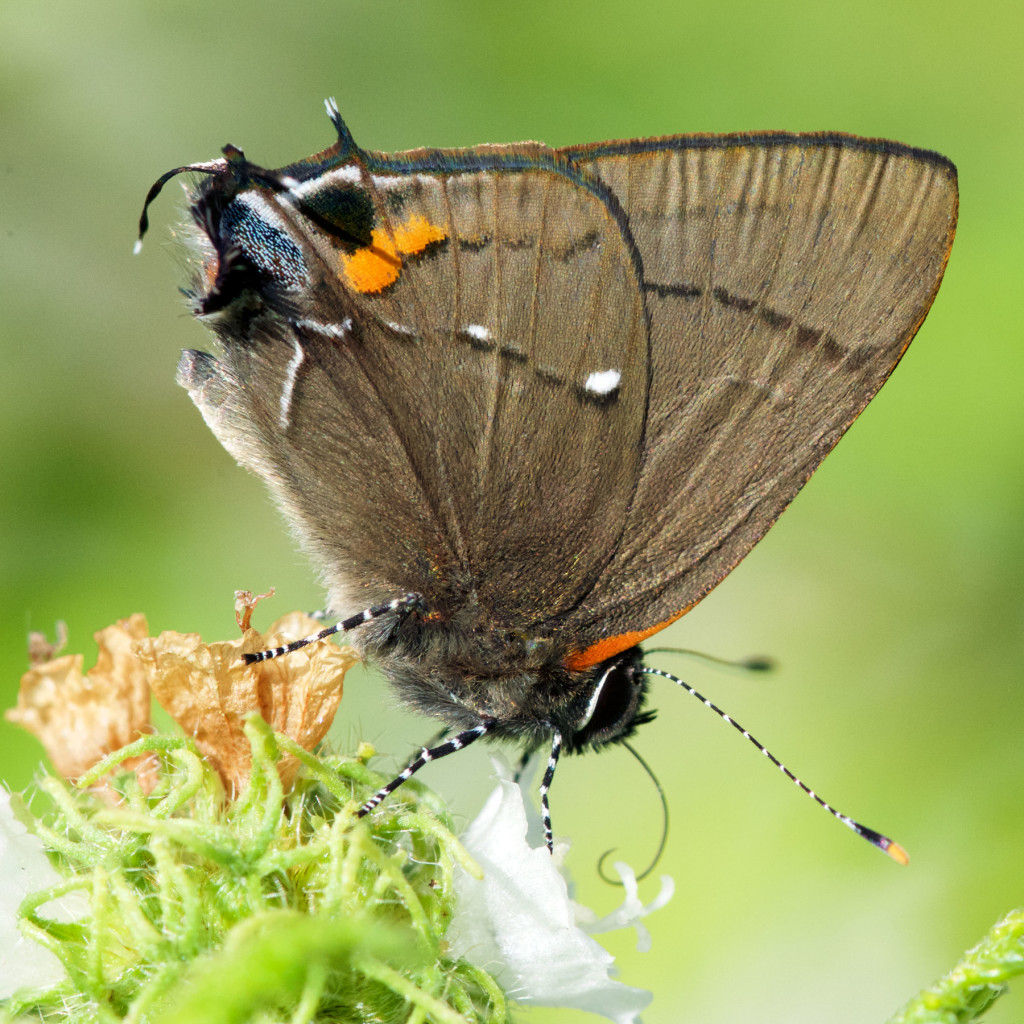It doesn’t take long to “survey” the yard when you’re a backyard naturalist. A few minutes in the morning, as long as you actually get out and do it, can have some interesting results. This morning, as I was grinding through the normal workaday toil, I decided I simply hadn’t been outside enough for the day. So I took my camera and wandered around the front and back yards for about five minutes. And in those five minutes I found a butterfly that I’d never seen before!
It’s another hairstreak, like the very common Mallow and the much less common Martial, but this one is a relatively recent newcomer to Florida, having been definitively established only since the mid-70s: Fulvous Hairstreak.

Like most hairstreaks, it’s a small butterfly, with a wingspan less than one inch. And, like many hairstreaks, it’s fairly pretty. Perhaps the combination of those two traits was the reason William Chapman Hewitson (1874) bestowed the species name (angelia); said species name is almost certainly behind one of its common names, Angelic Hairstreak.
While it’s always nice to see new butterflies, especially ones that are rather strikingly handsome, this one brings up some decidedly mixed feelings. Its most common hostplant is the non-native invasive tree species Brazilian Pepper (Schinus terebinthifolius—often written as S. terebinthifolia because, Latin). The plant itself is fairly pretty when it’s in fruit, as the huge clusters of tiny red berries against the dark green foliage give it a festive appearance. It was first imported as an ornamental in the 90s—the 1890s1—and, because it thrives in this environment, became very popular.
A couple of common names from back in the 50s when it first found widespread cultivation as an ornamental in south Florida were “Florida Holly” and “Christmas Berry.” And on the surface, what’s not to love? It’s fairly pretty, particularly when trimmed up as a specimen rather than allowed to grow to its natural form (basically, a 30-foot sprawling globe), it grows and propagates easily, and it has high wildlife value—the birds love the berries (which allows it to spread easily via seed transport, aka the poop train).
But dig a little deeper and you discover that perhaps this plant isn’t so nice:
- It’s a member of the cashew family (Anacardiaceae) and, like its cousins in that family (think poison oak, poison ivy, poison sumac), is a skin irritant. So just trimming it up to look nice can cause sensitive types (like me) to break out into a painful rash.
- It also produces allelopaths, chemical substances that inhibit the growth of other plants in its area. Like a planet, it clears its own orbit.
- Its so easy to grow that it currently dominates over 700,000 acres in Florida, making it the number one invasive plant species in the state.
And now, back to our butterfly. As Cech and Tudor wryly observe
Given the abundance of Brazilian Peppers in Florida, it is surprising that the Fulvous hairstreak is not one of the state’s most prevalent butterflies.
It isn’t though. This sighting was my first in the fifteen years I’ve lived in Florida. As Cech and Tudor continue:
While it does often occur in swarming local colonies, the Fulvous is not an everyday sight throughout its range. It poses no visible threat to its hostplant’s viability, based on it apparently modest appetite as an herbivore.
More’s the pity, some might say.
Sometimes I don’t know whether to admire or curse Nature’s whimsy. Beautiful native plants like the Fiddlewood (Citharexlyum fruticosum) get stripped down to twigs by the fiddlewood roller (Epicorsia oedipodalis, a fairly ugly little caterpillar that grows into an even uglier moth), yet the beautiful butterfly that feeds on Brazilian Pepper doesn’t even put a dent in that noxious weed.
Still, I suppose it’s a good thing that I don’t see too many of these little butterflies in my yard; it means there aren’t too many Brazilian Peppers in my neighborhood.
There’s also another way of looking at it: there are reports from Cuba of this butterfly feeding on a diverse genus of wildflowers, Salvia, of which I have several different varieties in both front and back yards. If the south Florida hairstreaks feed on Salvia as well, I won’t mind having them around at all!
References
Cech, R. and G. Tudor. 2005. Butterflies of the East Coast: an observing guide. Princeton, NJ: Princeton University Press.
Glassberg, J. 2012. A Swift guide to butterflies of North America. Sunstreak.

Hello, i am with the Broward NABA Chapter and just came across this butterfly in my backyard in Davie FL. Saw them for the first time last week. More than 5 nectaring on Cordia globosa.
I will habe to see if any feed on Salvia as I have much of that.